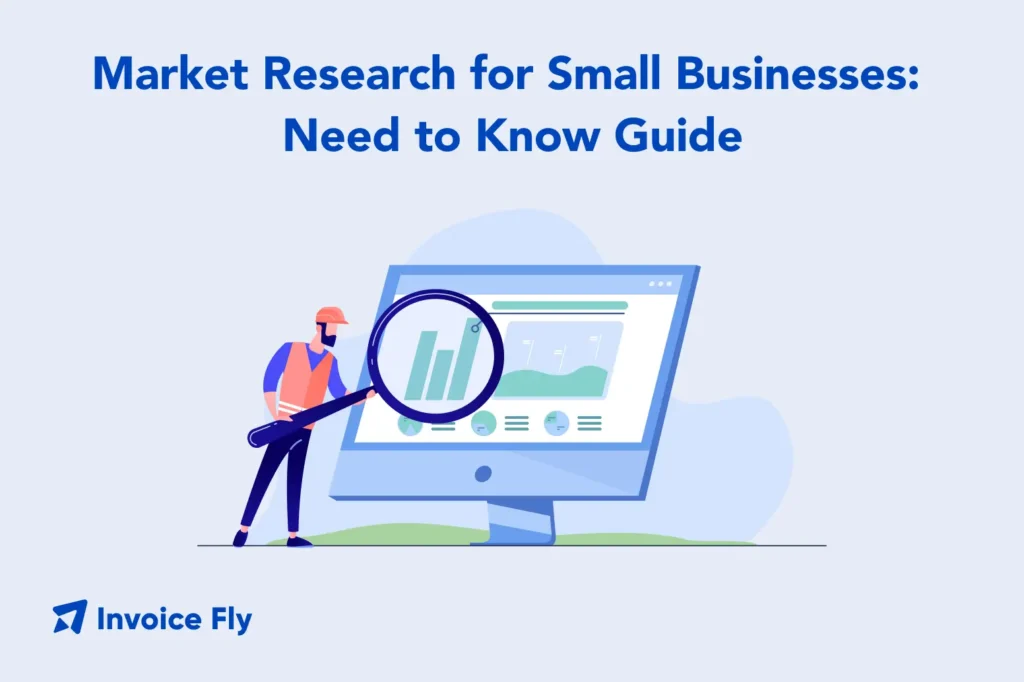Market Research for Small Businesses: Need-to-Know Guide

Table of Contents
- What is market research?
- Why you need to conduct market research
- How to do market research for small business startups
- Types of market research explained
- Best market research resources
- Gather data on your business and industry
- Costs of conducting market research
- Free and cost-effective ways to do market analysis
- Common market research mistakes to avoid
- Final Thoughts
- FAQs about Market Research for Small Businesses
In today’s competitive market, running a small business without market research is like driving with your eyes closed. You might move forward, but the odds of ending up where you want are slim.
Market research for small business owners isn’t just for big corporations with deep pockets. It’s the tool that lets you understand your customers, spot opportunities, and make decisions with confidence instead of guesswork.
Whether you’re launching your first startup, introducing a new product, or expanding into another market, knowing your audience and industry trends can be the difference between thriving and just surviving.
In this guide, we’ll explore:
- What market research is and why it matters
- How to conduct market research for entrepreneurs and startups
- The different types of market research
- Trusted resources you can use (many are free!)
- The costs and cost-effective ways to do it
- Common mistakes to avoid
- Real-world examples and tips you can apply today

What is market research?
Market research is the process of gathering, analysing, and interpreting information about your target market, competitors, and industry trends.Think of it as doing your homework before making expensive decisions.
For a small business, market research answers essential questions like:
- Who are my customers?
- What do they want?
- How much will they pay?
- Who else is selling to them?
- Where are the gaps in the market?
The U.S. Small Business Administration (SBA) calls market research one of the most crucial steps for reducing risk before launching or growing a business..
For example:
- A local coffee shop might study foot traffic patterns before signing a lease.
- An online home décor store could analyse Pinterest trends to choose which products to feature.
- A landscaping company could use free U.S. Census Bureau data to identify neighbourhoods with a high percentage of single-family homes—prime prospects for lawn care services—before targeting those areas with flyers and local ads.

Why you need to conduct market research
You’ve probably heard the phrase “know your customer.” Market research makes that possible. For entrepreneurs and startups, it’s about more than selling. It’s about survival.
Three big reasons it matters:
- Customer insights – Discover who your customers are, what motivates them, and how they make buying decisions.
- Competitor analysis – Identify what your competitors are doing well—and where they’re falling short.
- Data-driven decisions – Swap guesswork for informed strategy.
And the numbers back this up: According to Salesforce, 66% of customers expect companies to understand their unique needs. Without research, meeting those expectations is almost impossible.
Pro tip: The better you understand your customers now, the easier it will be to build accurate financial projections later. Not sure how to get started? See our Step-by-Step Guide on what are financial projections?
How to do market research for small business startups
Market research might sound intimidating, but it’s really about breaking a big task into small, manageable steps. Whether you’re a solo entrepreneur testing an idea or a small team preparing for launch, the process is the same: gather the right information, analyse it, and act on it.
Here’s a simple framework you can follow:
- Define your goal – Are you testing a new product, finding your target audience, or identifying a location? Before you even start gathering data, it’s worth making sure you’ve chosen the right legal and operational foundation for your business. If you’re still deciding, our guide on How To Choose Your Business Structure: 2025 Step Guide explains the pros and cons of each option so your research aligns with your long-term goals.
- Identify your target market – Use demographics (age, income), psychographics (lifestyle, interests), and geographic data.
- Choose your research method – Combine primary research (new data) and secondary research (existing data).
- Collect and analyse – Use tools like Google Forms for surveys or the U.S. Census Bureau for free demographic info.
- Apply your findings – Adjust your pricing, marketing, or product based on what you learn. Once you’ve analysed your results, you’ll want to capture your strategy in a formal plan. Our How to Write a Winning Business Plan: 2025 Ultimate Guide walks you through turning your market insights into a clear roadmap for growth.
Case study:
A boutique fitness studio in Austin surveyed residents about class preferences before opening. They discovered a strong demand for early morning classes, which shaped their schedule from day one. Within three months, their 6 a.m. classes were fully booked.
Types of market research explained
There are two main types of small business market research:
1. Primary market research
This is first-hand data you collect directly from your target audience.
Methods include:
- Surveys (SurveyMonkey, Google Forms)
- Focus groups
- One-on-one interviews
- Observations (e.g., watching foot traffic in a retail area)
Why it works: It gives you fresh, specific insights into your customers.
Example: A bakery owner could run a quick survey on Instagram Stories asking followers which pastry flavour they’d like to see next.

2. Secondary market research
This uses information that’s already been collected by others.
Sources include:
- Government statistics (U.S. Census Bureau, BLS)
- Industry reports (Investopedia, CFI)
- Academic studies
Why it works: It’s often free or inexpensive, and it can help you understand the bigger market picture.
Example: A pet supply store might use Census data to target neighbourhoods with high pet ownership rates.
Best market research resources
Here’s a shortlist of trusted sources:
U.S. government resources
- SBA – Small business market research guides
- U.S. Census Bureau – Demographics and economic data
- Bureau of Labor Statistics – Employment and wage trends
Industry summaries
- Investopedia – Industry definitions and analysis
- Corporate Finance Institute – Market research methods explained
Business location tools
- Google Trends – See what’s being searched
- Yelp – Understand local competition and reviews
Survey tools
- SurveyMonkey – Easy-to-use online survey tool
- Typeform – Attractive, mobile-friendly forms
- Google Forms – Free and simple option
Trade & industry associations
These often provide exclusive market data and reports. Example: The National Retail Federation releases annual consumer trend studies.
Market trends
- Statista – Global statistics and insights
- YouTube & TikTok – Track viral trends and consumer preferences
Gather data on your business and industry
The smartest small business market research blends internal and external data for a complete view.
Internal data comes from your own operations, such as:
- Sales figures – Identify bestsellers and slow movers.
- Customer feedback – Spot recurring praise or complaints.
- Web analytics – Track visitor behaviour on your site.
External data is gathered from outside sources and shows the bigger picture:
- Industry growth rates – See if your market is expanding or shrinking.
- Competitor pricing – Position your offers effectively.
- Seasonal demand trends – Plan for busy and slow periods.
Example:
A landscaping company might see from internal bookings that spring is its busiest season, then confirm through industry reports that demand peaks in April–May nationwide, helping them plan staff and marketing around the rush.
Costs of conducting market research
The cost of market research for small business can vary widely. Some methods cost nothing but your time, while others require a larger investment for deeper, more customised insights.
| Type | Example Methods | Typical Cost Range | Best For |
| Free / Low-Cost | Government databases (U.S. Census Bureau, Bureau of Labor Statistics), social media trend tracking, DIY surveys (Google Forms, Typeform) | $0 – $50 | Testing ideas, early-stage startups, ongoing light research |
| Paid – Moderate | Industry reports (Statista, IBISWorld) | $300 – $1,500 | Understanding market size, competitor landscape, growth forecasts |
| Paid – High-End | Commissioned market study from a research firm | $5,000 – $15,000+ | In-depth competitor analysis, customer interviews, geographic market mapping |
Since market research is an investment, it’s smart to think about how you’ll protect your business once you start acting on those insights. Our Need-To-Know Small Business Insurance Guide: 2025 Guide explains the coverage options that can help you manage risk as you grow.
Paid options:
- Industry reports ($300–$1,500) – Providers like Statista or IBISWorld offer detailed market size, growth forecasts, and competitor breakdowns.
- Commissioning a market study ($5,000–$15,000) – A professional firm can deliver tailored insights, such as in-depth homeowner interviews, competitor mapping, and seasonal demand analysis.
Example: A roofing company thinking about offering solar panel installation could start by using free U.S. Census data to find areas with high homeownership rates and sunny climates. If the data looks promising, they might invest in a paid report to analyse local solar adoption trends and competitor pricing before launching the service.
Free and cost-effective ways to do market analysis
You don’t need a corporate budget to get results. Here are some options:
- Install Google Analytics on your site to track visitor behaviour.
- Monitor competitor reviews on Yelp to identify weaknesses.
- Use free trials of survey or SEO tools before committing.
For solo founders, staying efficient is key. Our article on How Solopreneurs Can Build a Business Empire in 13 Steps in 2025 covers practical strategies for growing your business without burning out—many of which start with smart, lean market research.
Common market research mistakes to avoid
Even experienced entrepreneurs slip up when it comes to research. Here are some pitfalls to watch out for:
- Asking leading questions – If you phrase a survey question to get the answer you want, you’ll get biased data.
- Relying on too few people – Asking just friends and family won’t give you a clear market picture.
- Ignoring competitor analysis – Knowing your competition is just as important as knowing your customer.
- Failing to act on insights – Data is only valuable if you use it to make decisions.
- Treating it as a one-time task – Markets change; so should your research.
Mini case study:
A food truck owner asked only regular customers about menu changes. The feedback was positive. But sales dropped when the new menu launched because it didn’t appeal to occasional buyers. A wider survey could have avoided the mistake.

Final Thoughts
Market research for small businesses isn’t a one-off task you tick off the list—it’s a habit that should be woven into your ongoing business strategy. Markets shift, customer preferences evolve, and new competitors enter the scene. The businesses that thrive are the ones that keep listening, learning, and adapting.
By blending free resources, smart digital tools, and the occasional paid deep-dive, you can make confident, data-driven decisions without draining your budget. Whether you’re fine-tuning your pricing, deciding where to advertise, or launching a brand-new service, your research will give you the clarity to move forward with less risk and more certainty.
And remember, good research isn’t about collecting endless data, it’s about finding insights you can act on today.
Need an invoicing solution that works as hard as you do?
Try Invoice Fly’s Invoicing Software — It’s free!
FAQs about Market Research for Small Businesses
The main four are: primary (your own data from surveys or interviews), secondary (existing reports or studies), qualitative (opinions, motivations, behaviours), and quantitative (numerical data like percentages and sales figures).
DIY methods can be free, while paid industry reports often range from $300 to $1,500. Hiring a research firm for a custom study can cost $5,000–$15,000 or more.
A restaurant thinking about adding a vegan menu could survey customers, run an Instagram poll, and check Yelp reviews to see if there’s enough demand before launching.
They’re Product, Price, Place, Promotion, and People—covering what you sell, how much you charge, where it’s sold, how you promote it, and who your customers are.
It can take time, cost money, and sometimes produce biased or outdated results if done poorly or without a big enough sample.
At least once a year, but ideally whenever you’re launching something new, entering a new market, or noticing a drop in sales. Markets change quickly, your research should keep up.
